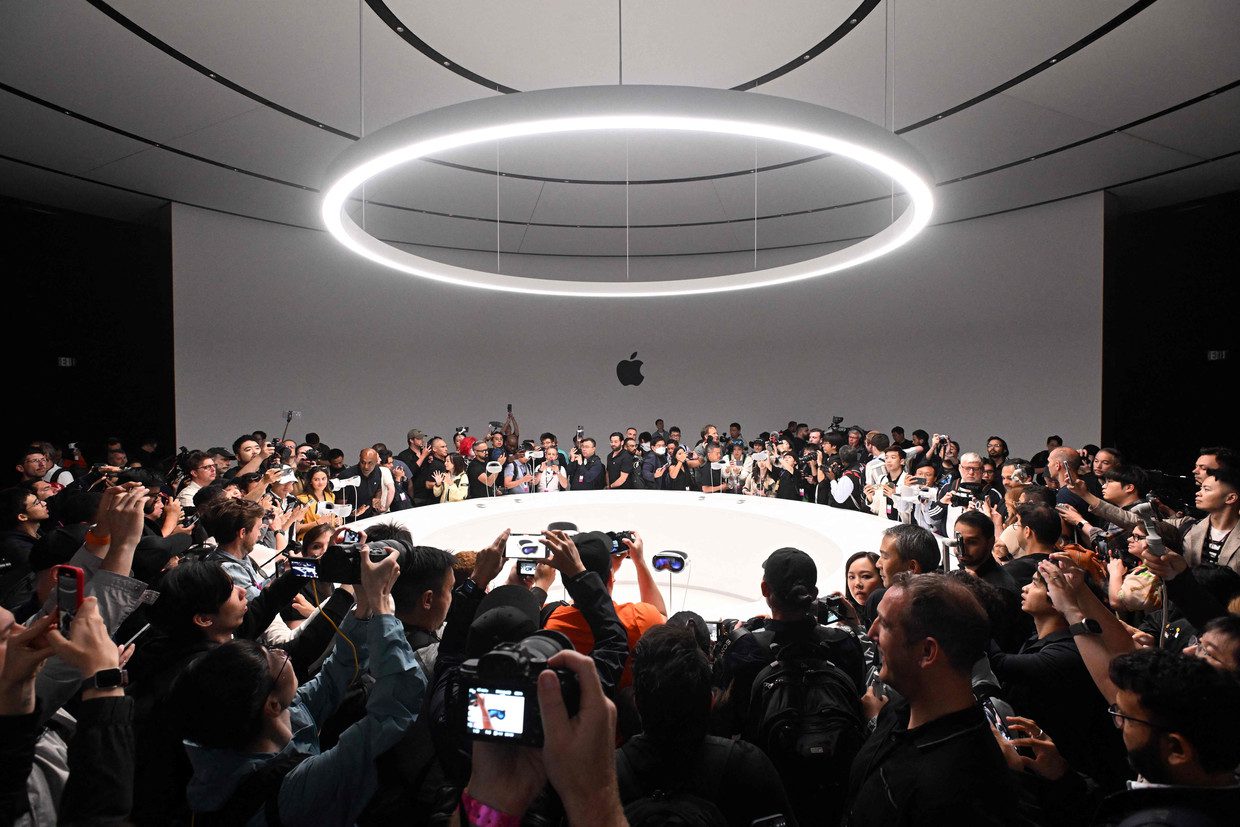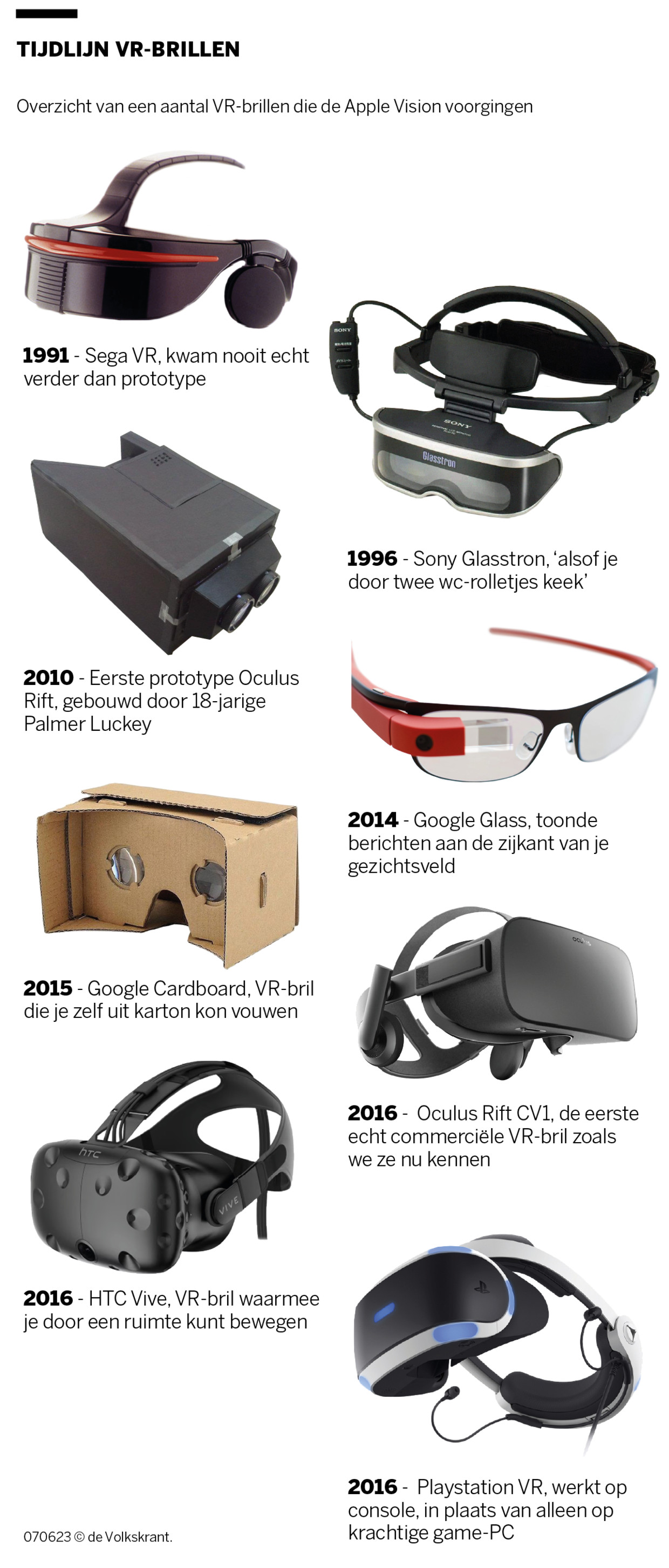Here it is, after long speculation: Apple’s virtual reality glasses. Vision Pro pulls apps from your phone and displays them around you in the room. The launch of the device comes with great expectations. However, the average consumer will not soon fall on the couch with it, if only because of the exorbitant price tag.
spatial computing. This is how Apple sees the future of virtual reality, or rather: Mixed reality. The fusion of the virtual and the real world, made possible by a pair of stocky ski goggles that cost less than 3,300 euros.
While competitors like mother Meta with Facebook’s VR glasses are essentially working toward a virtual world in which you completely disappear to play games or meet people, the Apple Vision Pro is a device that smears your computer or phone screen onto your surroundings.
Think of a movie playing life-size in front of you while you’re sitting on the couch, as you see text messages pouring out onto the coffee table—at least, if you like, because you can also completely black out your surroundings.
Don’t expect us to collectively work on presentations or read applications with that virtual diving mask in a few months. The Vision Pro won’t be available for sale until early 2024, and then only in the United States.

“Compare it with the presentation of the first iPhone,” says Jelle Prins, app designer for Uber and CoronaMelder, among others, after showing the Apple Vision Pro. The first iPhone was a revolutionary device, but what did it actually contain? Calculator, camera, notes. No GPS, no acceptable internet. Just a year after the presentation, third parties were able to develop their own applications, and the arrival of 3G expanded the possibilities. Prins: “To appreciate the potential of Vision Pro, you have to keep in mind that there will be more applications in the future.”
The first Vision Pro can be seen as a preview, intended primarily for developers and die-hards. By the time the device also hits the market in Europe, a second (slightly) cheaper version of the glasses may already be released.
An impressive device
None of this detracts from the fact that the Vision Pro is an impressive device. The tech journalists who have worn it have largely praised it. No controllers or remotes needed to control: the glasses record what you see. By moving your thumb and forefinger, you can tap, scroll or zoom without having to stretch out your hands like a zombie.
To maintain contact with your surroundings, Apple has built in a function where a person entering a room automatically appears in your field of vision. In addition, Vision Pro projects the wearer’s eyes onto the outside of the eyeglasses. As a result, you as a user can make more or less eye contact with the people around you. And those people, in turn, know they’re being seen (see the YouTube video at the bottom of this story for an explanation).
According to Prinze, this is just the tip of the iceberg. “Apple has applied for a large number of patents for sensors that can determine your state of mind.” Eye movements, pupillary dilation, and heart rate provide metrics that tell Apple devices how you’re feeling. Apple can adjust what you hear and see as a user.
Prins: “My phobia of snakes has infected my device in no time. And so you can add snakes to a game or movie, or leave them out, depending on whether or not you want to get a real creep. According to Prins, this may explain why Apple primarily presents the Vision Pro as a do-it-yourself device, while Apple’s competitor Meta, Facebook’s parent company, sees VR as a tool for experiencing a shared experience with other people in a virtual environment. world.
augmented reality
In doing so, Apple is clearly choosing to focus on AR: augmented reality, where a virtual layer is added to the real world. Useful if you want to fix a faucet, for example. Now you’re playing a YouTube video and have to use your dirty fingers to pause, fast-forward, and rewind a bit—soon the instructions will be right in your field of vision, you can ask the glasses out loud questions, like: The hell is the faucet spindle?
Apple is not the first nor will it be the last to develop this type of technology. And it remains guessing if we’ll all soon be blindfolded to our own personal version of Jungle Book Sit and watch – one with, the other without snake ka. However, Apple has presented an incredibly powerful device that offers developers a lot of possibilities.
This wouldn’t be the first time that Apple has been able to generate interest in a new market among the general public. Lots of people laughed at the cordless earbuds, you lose them instantly, when you insert the AirPods. Apple now has about 10 billion euros in this market each year.
But with a price tag of more than 3,300 euros, the Vision Pro (or later versions) will either have to drop its price significantly, or offer the rich an excellent experience, if this product is to be such a success.


“Lifelong zombie fanatic. Hardcore web practitioner. Thinker. Music expert. Unapologetic pop culture scholar.”








